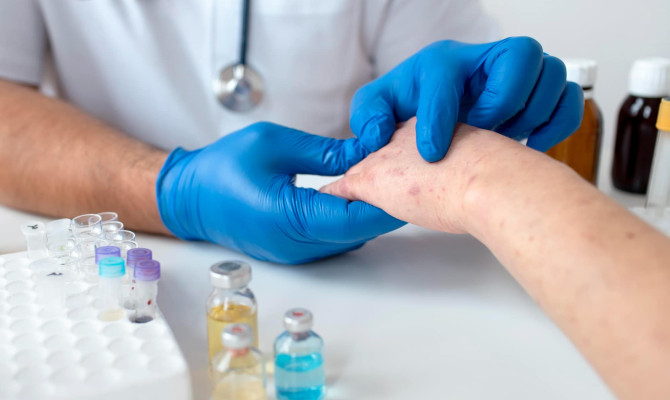Prostatectomy: A Surgical Solution For Prostate Cancer

- Prostate Cancer
- 15 Sep 2023
Overview
Prostatectomy
A prostatectomy is a surgical intervention that eliminates some or the entire prostatic gland. The primary objective of it is to treat conditions related to prostates, such as prostate cancer or benign prostatic hyperplasia (BPH). The surgical approach is influenced by various factors, such as the patient’s medical history, prostate size, and surgeon’s proficiency. The two most common approaches to prostatectomy are retropubic or suprapubic approach which involves making an incision in the lower abdomen and the perineal approach, where the incision is made through the perineum.1 Overview| Researched based study from Journal of the National Cancer Institute After surgery, patients will need proper care and follow-up to ensure a successful recovery and long-term health management.

Prostate Gland
What is Prostate gland?
- The prostate gland is a compact, muscular, and glandular organ situated deep within the groin. It’s a very important component of the male reproductive system and has several key functions.
- It is composed of three lobes, which include a central lobe and one lobe on each side. The glandular tissue of the prostate contains numerous glands that produce and secrete the prostate fluid.2Prostate Gland| Researched based study from Science Direct
- It is responsible for secreting a mildly alkaline fluid that is part of the seminal fluid. This fluid helps to nourish and protect the sperm, allowing them to survive in the acidic environment of the female reproductive tract.
- Semen is produced by the combination of seminal fluid and sperm from the testicles during ejaculation.
- The anatomical structure and functions of the prostate gland are vital for male reproductive and urinary health. The increase in size of the prostate gland in advance age is caused by Benign Prostatic Hyperplasia. This can lead to urinary difficulties and impair urinary function.2Prostate Gland| Researched based study from Science Direct
Indications
Indications for Prostatectomy
Each type of prostatectomy has its own indications and considerations, and the selection of procedure is influenced by factors such as the patient’s health requirements, 1 Indications| Researched based study from Journal of the National Cancer Institute the extent of the prostate or cancer, as well as the surgeon’s skill.
The goal of the surgery may vary from removing cancerous tissue, relieving urinary obstruction 3Indications| Researched based study from BMJ Journals, or addressing other prostate-related issues.
- Benign Prostatic Hyperplasia (BPH)
- Localized Prostate Cancer
- Prostatitis
- Urinary Retention
Benign prostatic hyperplasia (BPH):
- Most men experience prostate crisis by the time they reach their mid-60s, which is an expected issue.
- The symptoms of BPH are represented by slow, disrupted, or weak urinary flow, urgency with leaking or dripping, and periodic urination, especially at night.1 Indications| Researched based study from Journal of the National Cancer Institute
Localized Prostate Cancer:
- Prostate cancer is a typical and profound health concern.
- In men over 50, prostate cancer is the most usual kind of cancer, and it is the third major reason of death from cancer, as described by the American Cancer Society.
Prostatitis:
- In some instances, surgical intervention may be necessary due to severe and chronic inflammation of the prostate gland.
Urinary Retention:
- In the event that a man encounters continual or repeated urinary retention, which is the inability to vacant the bladder fully, prostatectomy may be considered.1 Indications| Researched based study from Journal of the National Cancer Institute 3Indications| Researched based study from BMJ Journals
If you experience any of these symptoms, contact a medical professional:
- Difficulty initiating urination
- Weak or interrupted flow of urine
- Urinating often, especially at night
- Blood in the urine or semen
- Persistent pain
- Trouble emptying the bladder completely
- Burning pain while urinating
Difficulty initiating urination:
- Struggling to begin the flow of urine or experiencing a delay in starting urination.1 Indications| Researched based study from Journal of the National Cancer Institute 3Indications| Researched based study from BMJ Journals
Weak or interrupted flow of urine:
- Having a weak or inconsistent stream of urine during urination.
Urinating often, especially at night:
- Frequent trips to the bathroom to urinate, particularly during nighttime hours.3Indications| Researched based study from BMJ Journals
Blood in the urine or semen:
- During ejaculation, blood present in the urine (hematuria) or semen can be detected.
Persistent Pain:
- Severe back, hip or pelvic pain that does not subside.
Painful ejaculation:
- Feeling pain or discomfort during ejaculation.
Trouble emptying the bladder completely:
- Feeling as though the bladder doesn’t completely empty after urination.3Indications| Researched based study from BMJ Journals
Burning pain while urinating:
- Feeling discomfort, pain, or a burning sensation while peeing.
Types
Types of Prostatectomies
There are 3 main types of prostatectomies and they are as follows:
- Radical Prostatectomy (RP)
- Transurethral Resection of the Prostate (TURP)
- Laparoscopic Prostatectomy
Radical Prostatectomy (RP):
It involves surgically removing the whole prostate. There are two ways:4Types| Researched based study from Springer Open
- Retropubic approach: To assess and remove the prostate gland, a surgical cut is made in the inferior part of abdomen.
- Perineal approach: The skin between the scrotum and rectum is cut to access and remove the prostate.
Transurethral Resection of the Prostate (TURP):
- An endoscope, which is a small, flexible tube with a light and lens, is utilized to remove part of the prostate gland through the penis in this approach.
- BPH can be treated with TURP by relieving urinary obstruction caused by a hypertrophied prostate.
Laparoscopic Prostatectomy:
- This method involves the removal of the prostate gland using small incisions and specialized surgical instruments.
- It is possible to perform it manually or with the help of a computer operated robot. 4Types| Researched based study from Springer Open
Types of Radical Prostatectomy
The primary objective of radical prostatectomy is to remove all prostate cancer when it is localized and confined to the prostate gland. This also removes the nearby tissues such as the seminal vesicles.
Radical prostatectomy can be done in multiple ways:
- Radical prostatectomy with a retropubic approach: The most common method, where the prostate gland and possibly nearby lymph nodes are removed through an incision in the lower abdomen.4Types| Researched based study from Springer Open 5Types| Researched based study from Central European Journal of Urology
- Anatomic Nerve-sparing Prostatectomy Approach: Involves attempting to spare the nerves responsible for urinary control and erectile function, although it may not always be possible.
- Laparoscopic radical prostate surgery: A little invasive approach involves making small incisions and a laparoscope is used to view and remove the prostate gland.5Types| Researched based study from Central European Journal of Urology
- Robotic-Assisted Laparoscopic Prostatectomy: A form of laparoscopic surgery performed using a robotic system, providing enhanced precision and control.5Types| Researched based study from Central European Journal of Urology
- Radical Prostatectomy with Perineal Approach: Less common but may be used when the nerves need not be spared or when other medical conditions prevent the retropubic approach.5Types| Researched based study from Central European Journal of Urology
Reasons for Radical Prostatectomy
Besides treating localized prostate cancer, radical prostatectomy may also be recommended for other less common conditions, such as:
Inability to Completely Empty the Bladder:
- When a man has difficulty fully emptying the bladder, radical prostatectomy may be considered to address the underlying issue.6Types| Researched based study from Science Direct
Recurrent Bleeding from the Prostate:
- Persistent bleeding from the prostate may necessitate surgical intervention to stop the bleeding.
Bladder Stones with Prostate Enlargement:
- Bladder stones in combination with an enlarged prostate may require removal of the prostate gland. 6Types| Researched based study from Science Direct
Very slow Urination:
- Severe difficulty in urination may be addressed with a prostatectomy to improve urinary flow.
Stress on the ureters and kidneys due to urinary retention (hydronephrosis):
- In situations where urinary retention causes increased pressure on the kidneys and ureters, a prostatectomy may be carried out to reduce the obstruction.
Preparation
Pre-procedure process before Prostatectomy
- Routine work up: Tests that can be done include blood samples, (ECG), chest X-ray, and a physical exam.
- Cystoscopy: Before performing the prostatectomy, the physician may conduct a cystoscopy to inspect the interior of your urethra and bladder.
- Antibiotics: Before surgery, you may be given antibiotics to lessen the risk of infection.
- Prescriptions Review: This includes all the over-the-counter drugs and supplements you are already taking.
- Quit taking Medications: To reduce bleeding risks during the surgery, it may be necessary to discontinue certain medications, such as aspirin, Coumadin, Plavix, Advil, or Aleve, a couple of weeks before the surgery.
- Smoking: If you smoke, let your doctor know as it can delay the restoring process after surgery.
- Fasting: You are not allowed to take anything for several hours before the operation.
- Use of Enema: It’s possible that you’ll be asked to use an enema or a laxative before the surgery to make sure your bowel is clear for the procedure.
Procedure
Radical Prostatectomy steps
Here’s a summary of the procedure of the general steps of a radical prostatectomy using a retropubic or suprapubic approach:
Patient Positioning:
- You will be lie on your back on the operating table.
Incision:
- The cut will be carried out by the surgeon from the umbilicus to the pubic area.
Dissecting the lymph nodes:
- In certain circumstances, the surgeon will first perform a lymph node dissection.
- The process involves carefully removing the nerve bundles from the prostate gland and identifying the urethra.
- If it’s necessary, it’s possible to remove the seminal vesicles.7Procedure| Researched based study from Springer Link
Prostate Gland Removal:
- It is then removed by the surgeon.
Drain Placement:
- The drain will be placed after the procedure, typically in the inferior area of the incision on the right side.
- The drain aids in removing any excess fluid or blood that may build up at the surgical site.
- In certain cases, nerve-sparing methods may be used to protect erectile function if possible.
Radical Prostatectomy with a perineal approach
Patient positioning:
- Your position will be in a supine position. (Lying on your back).
- In this position, the hips and knees will be fully bent, the legs will be spread apart and elevated, and the feet will be supported by straps. Stirrups will be used to support your legs.
Incision:
- The incision will be made in the perineal area in an upside-down, U-shaped fashion.7Procedure| Researched based study from Springer Link
Prostate gland removal:
- The doctor will make an effort to avoid any harm to the nerve bundles in the prostate area.
The seminal vesicles removal:7Procedure| Researched based study from Springer Link
- If there is concern about abnormal tissue in the seminal vesicles, they may be removed.
Completing Radical Prostatectomy using both methods
Suturing:
- The incisions will be re-stitched together. 7Procedure| Researched based study from Springer Link
Dressing:
- An aseptic bandage/dressing will be used.
Referral to Care Unit:
- You will be taken to the post-anesthesia care unit after being transferred from the operating room
After Care
Post Prostatectomy
You may go through discomfort and pain during the recovery period.
- Pain medication: To manage pain, your doctor will give you pain medicines.
- Drain placement: It’s possible that special tubes will be inserted into your body to drain any excess fluids. Monitoring and proper care of these tubes is necessary.
- Safety measures: To keep you safe, it is recommended that someone else bring you home after your operation. It’s best not to drive until your doctor approves and determines it’s safe for you to do so.
- Insertion of Urinary Catheter: Generally, the urine catheter should remain in place for 5 to 10 days.7After Care| Researched based study from Springer Link
- Recovery period: Getting back to normal can take between four and six weeks. Exercises or physical therapy may be recommended by your healthcare provider to help you recover.
- Follow-up Meetings: To monitor your progress, it is crucial to schedule follow-up appointments with your doctor.
Complications
Complications of Prostatectomy
It’s important to remember that each individual’s experience may vary, and not all patients will necessarily encounter all of these complications. Here’s a summary of potential post-procedure complications:
Urinary Incontinence:
- Urine leakage that is involuntary, may improve over time, but can still remain up to a year after surgery. Age may influence the severity of incontinence.
Bladder leakage or dribbling:
- Urine leakage or dribbling may occur at first, but it usually improves over time.8Complications| Researched based study from Indian Journal Of Urology
Erectile Dysfunction (Impotence):
- Sexual function may take up to two years to recover, and it may not fully return even with nerve-sparing techniques.
Sterility/ Infertility:8Complications| Researched based study from Indian Journal Of Urology
- Radical prostatectomy breaks the link between the testes and the urethra, resulting in retrograde ejaculation and infertility. It is likely for a person to have orgasm without ejaculation.
Lymphedema:
- Lymphedema is uncommon, but it can happen because of inflammation, obstruction, or the removal of lymph nodes during surgery. Swelling and discomfort in the legs or genital area can occur as a result of it.
Change in Penis size:
- A small number of surgeries can lead to a decrease in penis length.
- It is critical that patients discuss complications and potential risks with their health care providers prior to surgery.8Complications| Researched based study from Indian Journal Of Urology
FAQs
Frequently Asked Questions on Prostatectomy
Is prostatectomy a major operation?
- Yes. Surgery, specifically a radical prostatectomy, is an advance treatment option for prostate cancer. However, the decision to undergo surgery depends on various factors, including age, the aggressiveness of the cancer, and overall health.
- Like any major surgical procedure, radical prostatectomy has its own inherent risks. Bleeding and the chance of needing a blood transfusion, the likelihood of developing a chest infection, blood clots, and wound infection are some of threats that may exist.9FAQs| Researched based study from Frontiers
- Patients should be well-informed about the benefits and potential risks of radical prostatectomy, allowing them to make an informed decision in consultation with their healthcare team. 9FAQs| Researched based study from Frontiers
- Alternative treatment options, such as radiation therapy, may be considered for some cases, depending on the patient’s specific circumstances and preferences.
How is life after prostate removal?
- The overall prognosis is good, which is great news. The doctor will recheck the grade of the cancer cells and examine the margins to see if there are any cancers cells at the edge of the prostate.10FAQs| Researched based study from Science Direct
- The pathologists analyze the outer layer of tissue, and if they find cancer cells, it’s mostly a positive surgical margin (PSM).
- Negative margins indicate no cancer cells, while positive margins mean cancer cells were found at the edge.
How long does it take the urethra to heal after prostatectomy?
- It’s possible for swelling to develop after surgery, making it difficult to urinate.
- A catheter (a hollow tube) will be placed into your urethra for few days. Afterwards, the tube is detached.11FAQs| Researched based study from Journal of Yeungnam Medical Science
Takeaway
Takeaway points for Prostatectomy
- There are both benefits and drawbacks to prostate surgery. The advantages include complete removal of cancer if it’s confined to the prostate, thorough analysis and staging of the prostate in the lab, easy assessment of treatment success through PSA testing, and the possibility of receiving other treatments if needed.12Takeaway| Researched based study from Journal of Cancer
- However, there are also drawback of surgery such as bleeding, infection, and blood clots. It requires a hospital stay for a few days, and potential side effects after surgery may include problems with erections and urinary incontinence.8Take Away| Researched based study from Indian Journal Of Urology
Any feedback on this article?
 This Articles content was accurate
This Articles content was accurate Very Informative Article
Very Informative Article I have a question or a comment
I have a question or a comment
 This article contains inaccurate content
This article contains inaccurate content This article was not helpful
This article was not helpful I have a question or a comment
I have a question or a comment
We appreciate your helpful feedback!
Checkout our social pages
References
-
Journal of the National Cancer Institute
Overview | Indications
-
Science Direct
Prostate gland
-
BMJ Journals
Indications |Factors
-
Springer Open
Types
-
Central European Journal of Urology
Types
-
Science Direct
Types
-
Springer Link
Procedure | After care
-
Indian Journal of Urology
Complications | Takeaway
-
Frontiers
FAQs
-
Science Direct
FAQs
-
Journal of Yeungnam Medical Science
FAQs
-
Journal of Cancer
Takeaway





































